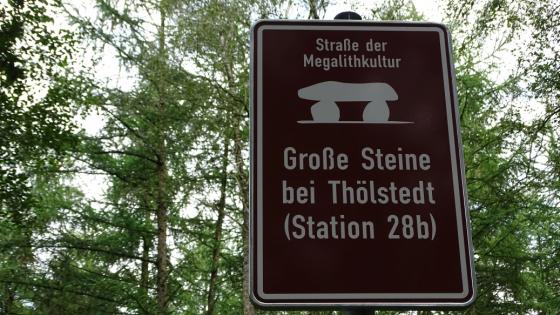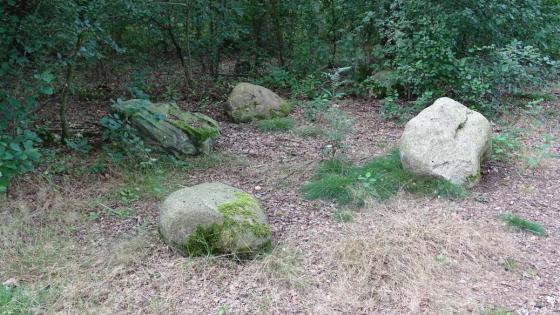
Visited July 2018

Visited July 2018
West of Wildeshausen, south of the A1 autobahn there are three groups of 2 megalithic tombs each with the name affix “Kellersteine”, the Steinloger Kellersteine, the Holzhauser Kellersteine and the Ahlhorner Kellersteine described here.
You can reach the Ahlhorner Kellersteine if you continue on the Bride Path from the Visbeker Bräutigam for about 750m. You come to a crossroads at a field where two roads come from the left. Take the second one leading northeast and after 200m a sign points the way to the right to the two tombs, which are about 50m in the woods.
Visited July 2018
taken from the “Faszination Archäologie” information board:
“Ahlhorner Kellersteine”
Neolithic megalithic tomb
Dimensions Tomb I: 11 x 3 or 2 m, Tomb II; 6 x 2 or 2.5 m
The “Ahlhorner Kellersteine” have a relatively good state of preservation. The capstone of Tomb II was only blown up at the beginning of the 20th century. Today, his fragments can be considered as a memorial of wanton megalithic destruction. The term “Kellersteine” (cellar stones) is probably based on the folkloric misinterpretation of the tombs as a storage cellar for goods.
The legend of the miracle stone
(De Wunnersteen)
According to legend, one of the capstones originally bore the inscription “O wunnder, o wunner, wat ligg hier wohl unner?” (Oh wonder, oh wonder, what may lie down there?). After a long puzzling, it was said, the capstone had been raised. But you could find nothing, nothing except the inscription “Dat würd nu uck all hoge Tied, Dat ick mal keem upp de annere Siet!” (Now it’s about time that I get to the other side!)
Testimony of sedentary life
Megalithic tombs like the “Alhhorner Kellersteine” are considered the oldest surviving structures of northern Central Europe. Until the fourth millennium BC only hunters and gatherers lived in the Wildeshauser Geest. Only the “funnel beaker culture” (about 3500 – 2700 BC) settled down permanently.
They bred cattle, planted grain and lived in post constructions. Presumably, they believed in an otherworldly life and therefore built their deceased sometimes monumental graves of boulders. Those megalithic graves or megalithic tombs (Greek: mega = large, lithos = stone) were erected not for individuals, but for groups and used over many generations.
330 kilometres of scenic route lead you to 33 exciting archaeological sites through Northwest Germany. On your way you will find more than 70 Neolithic (3.500 to 2.800 B.C.) megalithic tombs.





































